The Rainforest World Music Festival (RWMF) had been on my bucket list for years. A decade of pilgrimages to Sado Island’s Earth Celebration here in Japan had groomed me for the annual festival in Sarawak, featuring indigenous sounds from around the world. A window of opportunity opened to go, so I made a call to my good friend, artist and aficionado of all things music, Craig Yamashita, to convince him to come along. It wasn’t a tough sell.
Our flight from Tokyo went through Malaysia’s mainland capital, Kuala Lumpur, on the way there, and Kota Kinabalu, the capital of Sabah, on the way back. Our destination, however, was the other Malaysian “K” capital – Kuching.
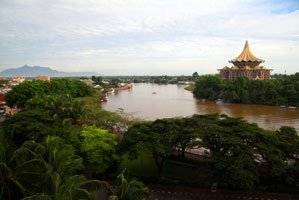
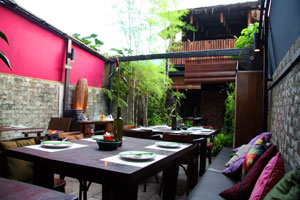
‘Cat City’
Having very little pre-flight intel, I assumed Kuching was a transit town for government lackeys and globetrotting hippies. We had booked into the Kuching Hilton, which I was half-expecting to be more like the “Hanoi Hilton.”
Arriving late, it wasn’t until the next morning that I discovered our amazing surroundings. Actually, I heard it first; the sounds of the rainforest woke me out of a deep, sultry sleep. When I opened the shades, it was like stepping into the movie “Avatar.” Framed within the large window was a handsome waterfront with a coffee-colored rainforest river lazing by a tree-lined promenade; beyond a golden pavilion stood stubbornly as if fending off the impending rainforest.
Kuching means “cat,” and we saw more than a few feline statues around this city that was one of many pleasant surprises on our short sojourn into Sarawak. Ours was a quick trip by intrepid standards. We were here for the three-day festival, but we had time for day trips each day before we headed out to the event. On our first day we toured the city, visiting the Sarawak Museum, craft center, city center, Tua Pek Kong Temple, the main bazaar and the Kuching waterfront.

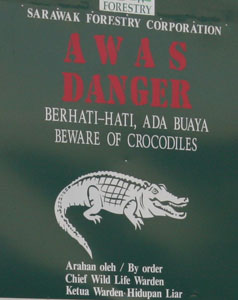
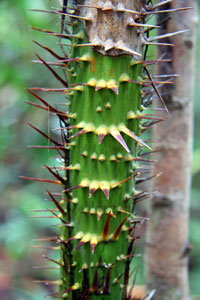
Revealed was Kuching’s surprisingly diverse history. North Kuching is mostly Malay, while South Kuching has a strong Chinese influence. Yet from the “white rajahs” who helped found the territory to Chinese merchants and indigenous tribes, the people here are proud of their diversity. They boast Sarawak is a place where Christians (30%), Buddhists (29%), Muslims (23%), Taoists (15%) and animists (5%) not only co-exist, but also start families together.
When I delicately broached the topic of some recent (at the time) religious unrest on the mainland, our local hosts openly acknowledged some of the problems there but genuinely noted Sarawak is a place apart.
Walking back to the hotel after our first full day, we heard some live music coming out of an eclectic spot called The Junk. When we walked inside, it felt as if we were in Minami Aoyama. A local musician, a recording artist in L.A., entertained the crowd who drank imported beer and wine from large glasses.
They seemed well educated and open, many from government families or those in the oil industry. There was a buzz in the air as the festival approached, and we enjoyed the conversation with new friends we’d see again over the next few days.
People of the Forest
Two things that came to mind before going to Borneo were orange monkeys and headhunters. On our second day, we were going to meet both. Our first stop was to the Annah Rais Bidayuh Longhouse. These raised wooden dwellings traditionally sheltered up to 100 families. Today you can stroll around or even stay overnight for a fee. Two smiling longhouse women greeted us when we arrived at 9 a.m., handing us each a shot of arak, the potent local rice wine, as we entered.
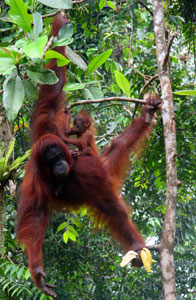
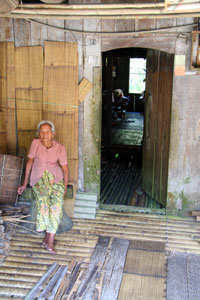
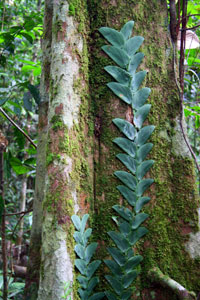
We were still shaking off the festivities from the night before, but when in a former headhunter’s house, we figured it might be prudent to accept. We walked through communal areas as cats lounged in the sun, children ducked in and out of doorways, and older residents sorted grain, dried bark for tea and busied themselves with other chores.
The longhouse chief invited us to sit down, poured more arak, and then encouraged us to try our hands, or mouths, at blow darts. I did not have any point of reference, but the arak did not seem to improve my accuracy.
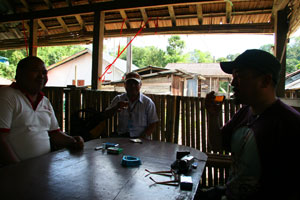

Next, we were off to the Semenggoh Wildlife Rehabilitation Center to meet the other people of the forest. The word “oran” means “people” and “utan” means “forest,” and the orangutan were feeding when we arrived. One large female was hanging by one arm, eating bananas with the other, while a baby clung to her shoulders.
You are not guaranteed to see these amazing creatures, as they are free to come and go as they please within the park, but chances are good during feeding time, and we saw several up close and others traversing the rainforest canopy high above our heads.
Bako National Park
A couple of kilometers inland from where the muddy river met the South China Sea, I was standing on the dock next to a not-so-subtle crocodile warning sign. Across the street, a fishmonger was chopping up a stingray with a machete. When our boat finally pulled up to take us to Sarawak’s oldest national park, I carefully got on.

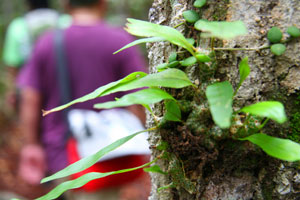
Bako is only 20 kilometers from downtown Kuching, but this 27-square-kilometer park is home to a diverse eco system of flora and fauna. Bearded pigs, carnivorous plants, macaques and big-nosed proboscis monkeys are just a few of creatures that call Bako home.
We spent hours hiking trails, but we could easily spend days exploring the 17 well-marked trails in the park. It’s an easy day trip, but an overnight stay in the park is recommended to give yourself ample time and the chance to join a night hike. During our trek, our guide pointed out the many changes in vegetation as we climbed from swamp to rainforest to sandstone.
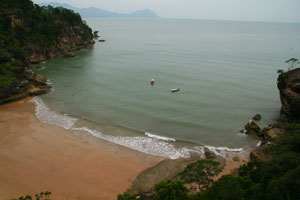
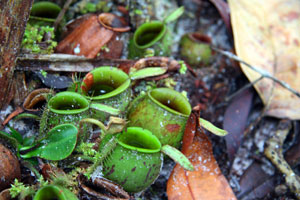
When we reached a lookout, we found ourselves staring down at a stunning crescent-shaped beach. It was hot and humid, and Craig single-mindedly headed straight down and into the water. I turned and asked our guide if there were any crocs around here, and he said he didn’t think so. I watched my friend floating unmolested in the cool water for a few minutes, and then I decided to join him.




